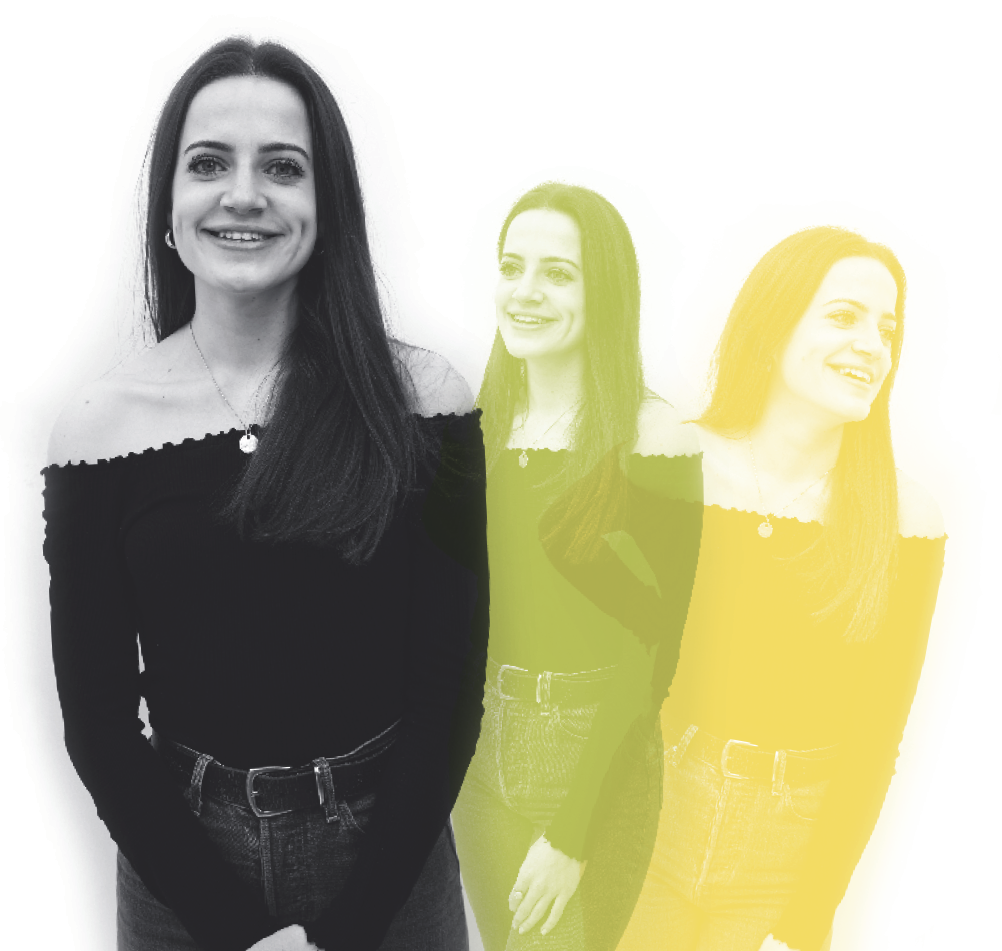
Final year project
The effect of ageing on skin wetness sensitivity across the body… [Read more]
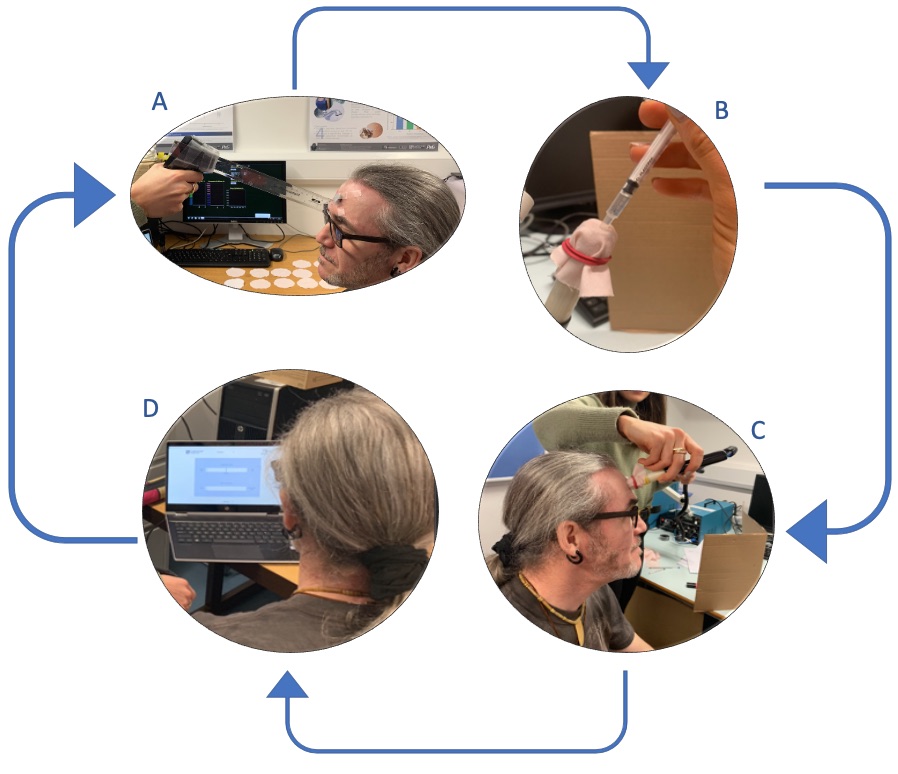
Schematic representation of the experimental design and protocol (answer aim 1 of the research project)
Aim 1: To compare wetness perception, thermal sensitivity and regional differences across the body in males in two contrasting age groups, between 18 to 25 and 50 to 65 years.
The flow diagram demonstrates the steps involved to deliver the stimuli and record the participants perceived responses. The body sites and stimulus temperatures were randomised for each participant, to prevent an order effect. Once part D was complete, a new temperature or skin site was tested (repeating stage A, etc).
A: Recorded the participants local skin temperature of the respective skin site (using an infrared thermometer).
B: Applying water to the stimulus and setting the temperature in accordance with local skin temperature (identified from part a).
C: Application of stimulus on a respective skin site (6 body sites tested in total).
D: Participants recorded their thermal and wetness perceptions using a visual analogue scale.
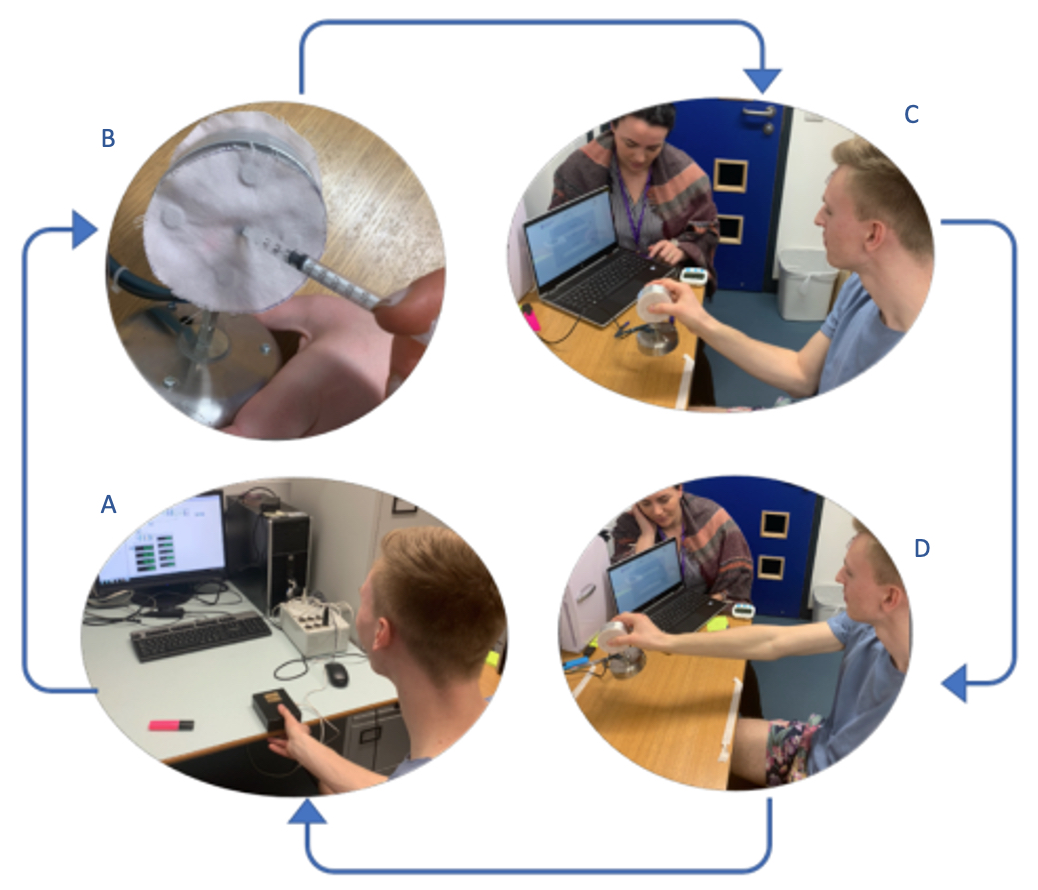
Schematic representation of the experimental design and protocol (answering aim 2 of the research project)
A: Participants skin conductance of their thumb and index finger were recorded.
B: A set volume of water was applied to the device (0.3mls).
C: Participant picked up the device using the pinch grip and reported their initial thermal and wetness sensation, they then held the device stationary for 20 seconds.
D: Participants moved the device 40cm forward, held it stationary for a further 20 seconds and place the device back onto the table.
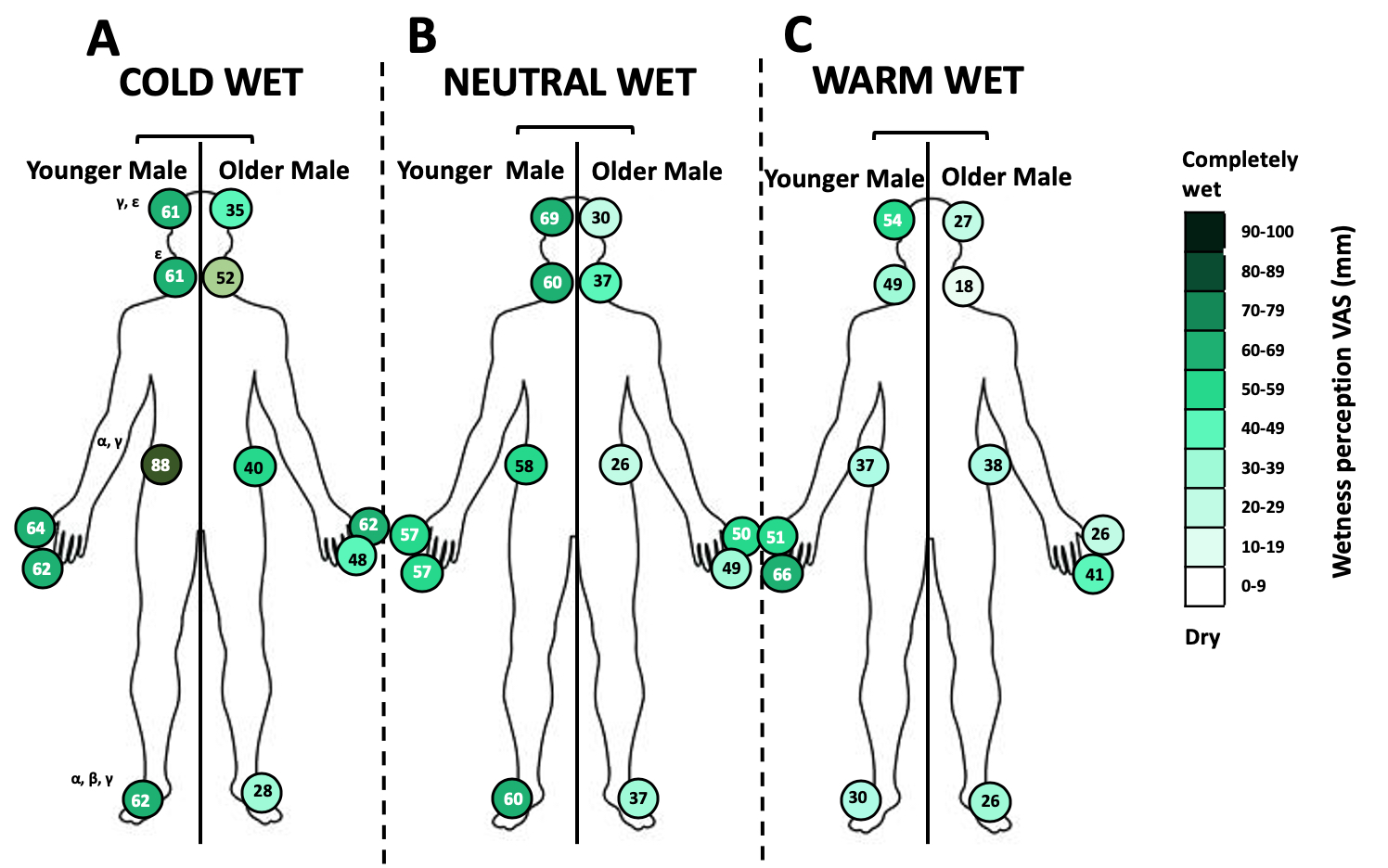
Hygrosensory body maps; body maps of wetness perception in younger (n=10) and older males (n=6), resulting from the application of cold wet (A), neutral wet (B) and warm wet (C) stimuli. The numerical data represents group means
It was concluded, on average, the younger age group was 22.8% more sensitive to the cold wet stimulus compared to the neutral and warm wet stimuli. Furthermore, the older age group perceived the neutral and warm wet stimuli 22.9% and 18.5% drier than the younger age group respectively.
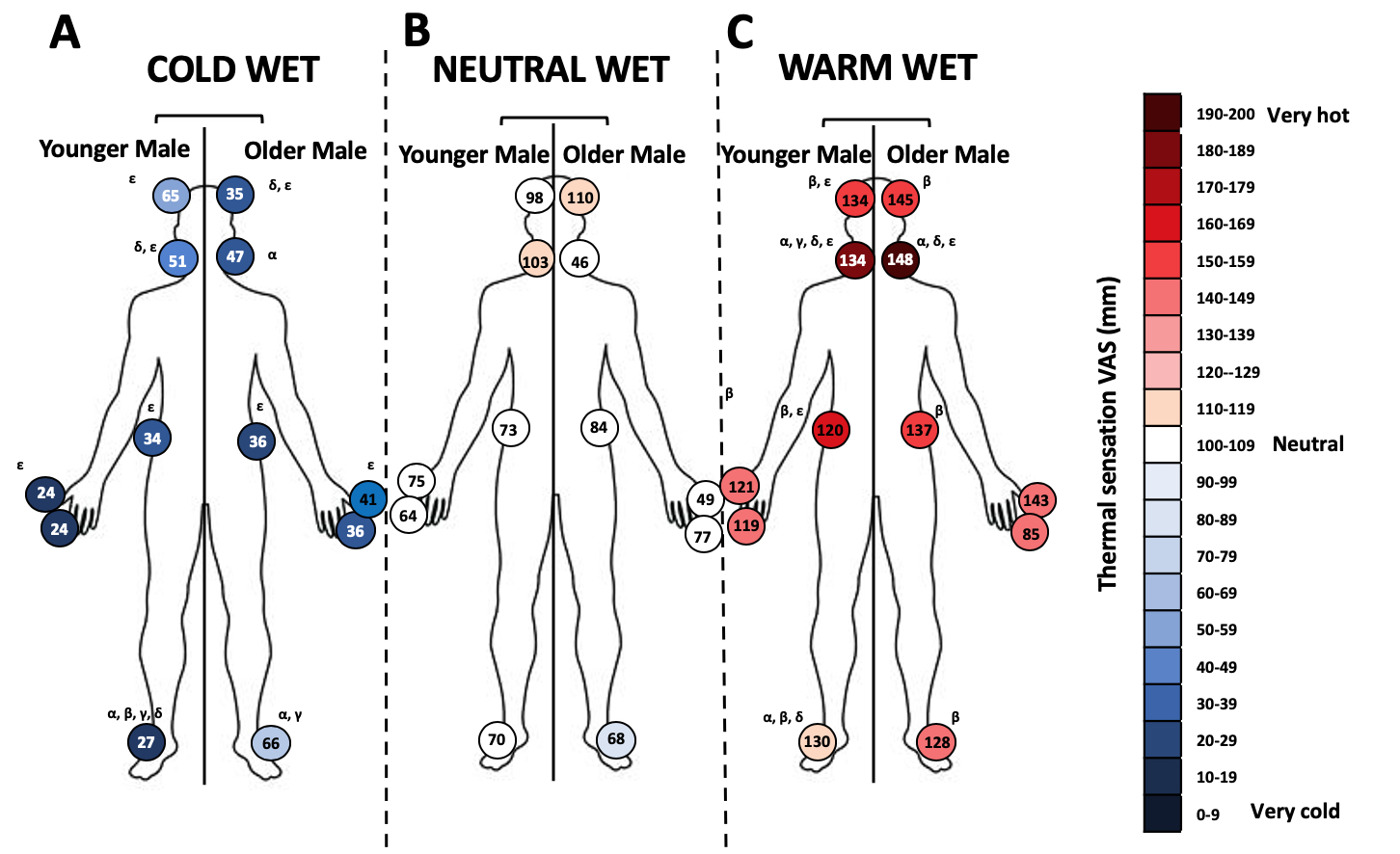
Thermosensory body maps; body maps of thermal sensations in younger (n=10) and older males (n=6) resulting from the application of the cold wet (A), neutral wet (B) and warm wet (C) stimuli. The numerical data represents group means
There were no age or regional differences in relation to the thermal sensation experienced by either age group. However, the cold-wet stimulus induced the greatest wetness perception compared to the neutral and warm wet stimuli, despite the same water volume applied to the device each time (0.8mls).
Charlotte Wildgoose
A highly motivated individual who is extremely passionate about design and adapting products or systems to improve efficiency, usability and safety for all potential users.
I was able to demonstrate my drive, commitment and enthusiasm to learn whilst working at an AIM listed city company during my placement year, where I was able to apply my Ergonomic and Human Factors understanding to enhance business performance for major corporate companies.
For my final year project, I researched the physiological effects of ageing and how this affects humans when interacting with their environment, with a particular focus on the perceptual changes which occur when perceiving a wet sensation on the skin and thermal cues from the environment. Understanding the somatosensory system is crucial when designing products and especially medical equipment requiring human precision. With a growing elderly population, understanding how the body changes with age is vital when designing effective and safe products for maximum comfort whilst minimising risks.
In the future, I would like to continue to expand my knowledge within the human factors discipline and help develop equipment and systems that improve the quality of people's lives. I am also hoping to gain my Ergonomic Chartership.
Final year project
The effect of ageing on skin wetness sensitivity across the body and the implication on hand dexterity
Awards
May '20 - Prepared an abstract for Physiology & Pharmacology of Tempter Regulation (PPTR) conference (Delayed due to COVID-19)
'20 Diploma in Professional Studies
Experience
August '18 – August '19 | Big Sofa Technologies
During my placement year, I worked as an Account Executive at Big Sofa Technologies. This involved supporting the client service team in analysing video data and turning it into structured information to understand human behaviour; some of the clients included Procter & Gamble, PepsiCo and General Electric.
Throughout my time at Big Sofa I managed time-critical projects, some involving twelve markets at a time. I managed high profile projects, which involved working under pressure, including debriefing clients in the U.K., Germany and Japan. While I was carrying out client work, I led an internal project developing a new video analysis strategy that focused on pinpointing design flaws and the impact on human behaviours. I used my ergonomics and human factors understanding to bring unique improvements to the projects. Following successful buy-in from the stakeholders and presentation to the senior management team, my work was rolled out to add further value for customers.
'15 – December '18 | The Children’s Trust
During my gap year, I qualified as a carer where I worked alongside medical professionals to provide complex care for children with profound disabilities as a result of a brain injury. This experience has proven invaluable for my understanding of human behaviour when using complex equipment and materials on the front line, giving me a greater understanding of usability and issues which can materialise when products are poorly designed. This experience demonstrates my organisational skills as well as my teamwork, communication and leadership ability.
Placements
August 2018 - August 2019
Account Executive , Big Sofa Technologies
November 2015 - December 2018
Children’s Support Assistant, The Children's Trust